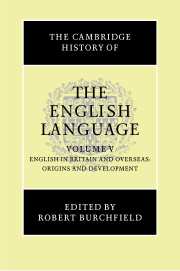Book contents
- Frontmatter
- 1 Introduction
- PART I Regional varieties of English in Great Britain and Ireland
- PART II English overseas
- 6 ENGLISH IN AUSTRALIA
- 7 ENGLISH IN THE CARIBBEAN
- 8 ENGLISH IN NEW ZEALAND
- 9 ENGLISH IN SOUTH AFRICA
- 10 ENGLISH IN SOUTH ASIA
- Glossary of linguistic terms
- Bibliography
- Index
- THE CAMBRIDGE HISTORY OF THE ENGLISH LANGUAGE
- Map 7.1 Movements of English/Creole speakers in the seventeenth century
- Map 7.2 Movements of English/Creole speakers after 1700
- References
6 - ENGLISH IN AUSTRALIA
from PART II - English overseas
Published online by Cambridge University Press: 28 March 2008
- Frontmatter
- 1 Introduction
- PART I Regional varieties of English in Great Britain and Ireland
- PART II English overseas
- 6 ENGLISH IN AUSTRALIA
- 7 ENGLISH IN THE CARIBBEAN
- 8 ENGLISH IN NEW ZEALAND
- 9 ENGLISH IN SOUTH AFRICA
- 10 ENGLISH IN SOUTH ASIA
- Glossary of linguistic terms
- Bibliography
- Index
- THE CAMBRIDGE HISTORY OF THE ENGLISH LANGUAGE
- Map 7.1 Movements of English/Creole speakers in the seventeenth century
- Map 7.2 Movements of English/Creole speakers after 1700
- References
Summary
Introduction
Dialects in contact
Australian English had its beginnings in the late eighteenth century in a convict settlement where people of diverse speech were brought together. Some levelling of dialects had probably already taken place in England or even at sea. The first settlers were especially important in setting the direction of linguistic development in the new land. The vocabulary of the language grew by borrowing from Aboriginal languages or by retaining or borrowing from English dialects, by extending the reference of existing resources or by conjoining existing elements in compounds or set phrases. The controlling force in directing the actual development of the language from these potential sources was the social experience of the inhabitants of Australia.
The people who established European settlements in Australia had no thought of changing the English language. Yet even before the Union Flag was raised at Sydney Cove on 26 January 1788 the forces of change had been at work. Most of the involuntary passengers had already left rural England for cities, accommodating their speech to their new neighbours there, and in some cases learning the ways of urban crime, though not all who were caught, perhaps in a single minor theft, were professional criminals. Then they were again thrown among people of varying background to learn the ways of prisons or to adapt to the new experience of a sea voyage lasting more than eight months. Finally the passengers of the several ships in the First Fleet, as it is always called, were brought together in the small settlement at Sydney Cove.
Keywords
- Type
- Chapter
- Information
- The Cambridge History of the English Language , pp. 275 - 327Publisher: Cambridge University PressPrint publication year: 1994
References
- 30
- Cited by



